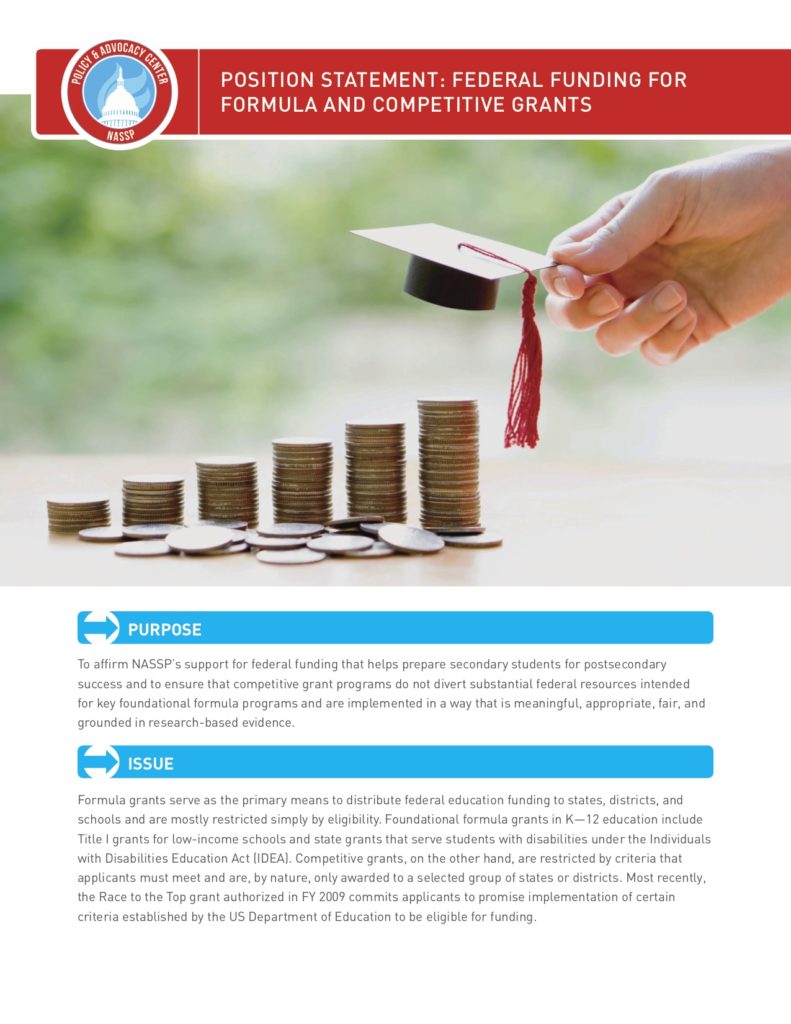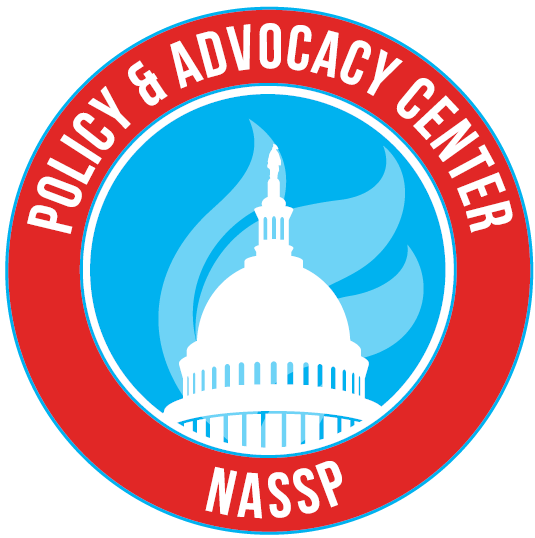Purpose: To affirm NASSP’s support for federal funding that helps prepare secondary students for postsecondary success and to ensure that competitive grant programs do not divert substantial federal resources that are intended for key foundational formula programs and are implemented in a way that is meaningful, appropriate, fair, and grounded in research-based evidence.
Formula grants serve as the primary means to distribute federal education funding to states, districts, and schools and are mostly restricted simply by eligibility. Foundational formula grants in K–12 education include Title I grants for low-income schools, state grants that serve students with disabilities under the IDEA, and grants that support the professional development of principals and other educators under Supporting Effective Instruction State Grants. Competitive grants, on the other hand, are restricted by criteria that applicants must meet and are, by nature, only awarded to a select group of states or districts.
In 2015, the federal government passed its most recent Elementary and Secondary Education Act (ESEA) reauthorization in the form of the Every Student Succeeds Act (ESSA). Replacing No Child Left Behind, ESSA did away with several controversial and ineffective competitive grants, most notably Race to the Top grants. ESSA also sought to eliminate confusion over grant application processes by consolidating dozens of federal grants into one block grant program known as Student Support and Academic Enrichment Grants. Currently, ESSA offers 12 state formula-allocated grant programs and 21 competitive grant programs. Unfortunately, many of these programs are severely underfunded, with several lacking any funding and no longer being distributed to states. Congress must realize the importance of proper federal investments in our nation’s schools to ensure equitable learning and growth opportunities for all students. The FY 2020 budget provided small increases for many of the formula and competitive grant programs, but still left the vast majority under their authorized levels, thus shortchanging our nation’s educators and students.
Schools are particularly concerned about funding for Title I and IDEA and the unfunded mandates that accompany these underfunded programs. According to the Committee for Education Funding, a coalition of more than 110 national education organizations, fully funding Title I grants would require an appropriation of approximately $45 billion annually, an increase of more than $30 billion over the FY 2020 allocation. Likewise, when IDEA was passed in 1975, Congress pledged to pay 40 percent of the excess cost of educating students with disabilities. Congress, however, has fallen far short of that promise, forcing states and districts to pay for the shortfall. In FY 2020, the federal share isn’t even at 17 percent, nowhere near the promised 40 percent toward full funding of IDEA. The federal mandates created by these programs are noble and help create a more equitable, positive learning environment for all students. However, schools across the nation are being forced to make difficult decisions regarding funding to adhere to these mandates. These funding decisions can often include staff cuts as well as delays to necessary infrastructure updates and possible other programs or resources aimed at benefiting students. Furthermore, the underfunding of these and other mandates puts our public schools on an unfair playing field with private schools who do not have to comply with such regulations. Congress’ hollow promises of appropriate funding levels must finally be met to give our schools their best opportunity to succeed.
Guiding Principles
The NASSP Board of Directors approved a position statement in 2002 and revised it in 2018 to affirm the association’s belief that federal funding of middle level and high school education is necessary to prepare students for postsecondary success and to offer recommendations for federal policymakers to help improve schools and student achievement.
Congress and state legislatures routinely approve laws that necessitate local compliance. To be effectively implemented, many of those statutes require adequate funding. The federal and state governments must provide appropriate resources to meet these mandates.
Federal funding should help achieve equity, not exacerbate inequity. For this reason, competitive grants that by nature award only some, not all, eligible entities should be authorized and implemented only when Congress identifies an opportunity to help achieve equity through the form of a competitive grant.
Recommendations
Recommendations for Congress
- Prioritize substantial education funding for formula grants that help achieve equity in per-pupil spending and that fulfill federal mandates over education funding for competitive grants, particularly those that do not directly address issues of equity in per-pupil spending or federal mandates.
- Prioritize funding for programs like Supporting Effective Instruction State Grants that ensure the improvement and placement of effective teachers, principals, and other educators in schools.
- Fund competitive grants that specifically address the educational needs of K–12 students, help achieve funding equity, and are guided by criteria for student achievement that is grounded in evidence-based research.
- Fully fund ESEA and IDEA at their authorized levels through formula grants.
- Refrain from authorizing legislation with mandates that go largely unfunded by Congress either because of political or fiscal circumstances and, therefore, place the burden of funding those mandates on states and districts.
- Take into account the risks and inherent selectivity of competitive grant programs and ensure that any development and subsequent implementation of competitive grants must thus be meaningful, appropriate, fair, and grounded in research-based evidence and have a realistic timeline for implementation. Also, ensure the creation of any new competitive programs are only available for distribution to public schools that comply with federal mandates.
Recommendations for the U.S. Department of Education
- Regularly and thoroughly review available nationwide data on indicators that contribute to student achievement—including per-pupil funding; attendance, graduation, and discipline rates; and school personnel, such as special education aides and specialized instructional support personnel—among other indicators.
- Propose competitive grant programs that are guided by criteria for student achievement and grounded in evidence-based research to meet the greatest areas of need revealed by the indicators. Also, refrain from using dollars from federally enacted formula grants to create new competitive grants.
- Provide adequate time and technical assistance to states and districts that apply for competitive grants, especially those that are in rural areas or have a significant proportion of low-income students, to ensure that all eligible entities have the capacity to submit strong applications and compete fairly.
- Provide proper guidance to help ensure states are using federal dollars to supplement not supplant state education funds.
Recommendations for State and Local Policymakers
- Assess their needs related to student achievement as well as their capacity before applying for a federal competitive grant program.
- Actively seek the assistance of the U.S. Department of Education in the application, clarification, and implementation of any competitive grants that they pursue and continuously communicate their needs and progress related to the competitive grants to adjust the timeline or other terms of the grant as needed.
Recommendations for District Leaders
- Advocate at the federal level for the full funding of ESEA programs and IDEA funds.
- Review federal grant opportunities and urge states to apply for grants that would boost equitable learning opportunities within their district.
Recommendations for School Leaders
- Advocate at the federal level for the full funding of ESEA programs and IDEA funds.
Resources
Committee on Education Funding. Education Matters, Investing in America’s Future: Fiscal Year 2020 Budget Analysis. Published May, 2019
Editorial Projects in Education. (2019, December 17). Special Education: Definition, Statistics, and Trends. Education Week. Retrieved from http://www.edweek.org/ew/issues/special-populations/.
Irish, L. (2019, March 5). How Unfunded Mandates Strain Schools’ Budgets. Retrieved December 19, 2019, from https://azednews.com/how-unfunded-mandates-strain-schools-budgets/.
National Conference of State Legislatures. Policies for the Jurisdiction of the Education Committee. Retrieved December 18, 2019, from http://www.ncsl.org/ncsl-in-dc/task-forces/policies-education.aspx#special%20education.
National Council on Disability. (2018, February 7). Broken Promises: The Underfunding of IDEA. Retrieved from https://ncd.gov/sites/default/files/NCD_BrokenPromises_508.pdf.
National Education Association. (2018, December 2019). ESSA Federal Funding Guide. Retrieved from http://myschoolmyvoice.nea.org/wp-content/uploads/2019/01/ESSA-Federal-Funding-Guide-2.pdf.
New Jersey School Boards Association. (2016, May). Unfunded and Underfunded State and Federal Mandates: A Burden on Local School Districts. Retrieved December 18, 2019 from njsba.org/wp-content/uploads/2016/05/Unfunded-Underfunded-Mandates-may2016.pdf.
Phenicie, C. (2019, June 21). Education Department Finalizes ‘Supplement Not Supplant’ Rules That Advocates Fear Could Harm Low-Income Students. The 74. Retrieved December 19, 2019, from https://www.the74million.org/article/education-department-finalizes-supplement-not-supplant-rules-that-advocates-fear-could-harm-low-income-students/.
Poiner, J. (2016, August 5). Increasing capacity: An overview of ESSA’s Student Support and Academic Enrichment Grant. Retrieved December 19, 2019, from https://fordhaminstitute.org/national/commentary/increasing-capacity-overview-essas-student-support-and-academic-enrichment.
U.S. Department of Education. (2019, June). Supplement Not Supplant Under Title I, Part A of the Elementary and Secondary Education Act of 1965, As Amended by the Every Student Succeeds Act Non-Regulatory Informational Document. Retrieved December 18, 2019 from https://www2.ed.gov/policy/elsec/leg/essa/snsfinalguidance06192019.pdf.
West, M. R. (2016, July 28). From evidence-based programs to an evidence-based system: Opportunities under the Every Student Succeeds Act. Retrieved December 19, 2019, from https://www.brookings.edu/research/from-evidence-based-programs-to-an-evidence-based-system-opportunities-under-the-every-student-succeeds-act/.


